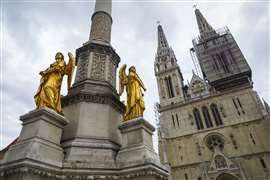Zagreb Cathedral utilizes scaffolding for renovation
30 June 2023
The Zagreb Cathedral – also known by its full name, the Cathedral of the Assumption of the Blessed Virgin Mary and Saints Stephen and Ladislaus – is one of the Croatia capital’s most famous landmarks.
Seemingly, the historic Gothic site has been the subject of construction and rebuilding projects off and on for most of the site’s approximate 800-year history since it was first built in the 13th century.
Lengthy reconstruction
 The Zagreb Cathedral has undergone many reconstruction and rebuilding projects in its history, and the most recent has erected scaffolding to fortify the building for future earthquakes. (Photo: Beata Zawrzel/NurPhoto)
The Zagreb Cathedral has undergone many reconstruction and rebuilding projects in its history, and the most recent has erected scaffolding to fortify the building for future earthquakes. (Photo: Beata Zawrzel/NurPhoto)
After a turbulent early history involving invaders such as the Mongols and the Ottoman Empire, the cathedral was severely damaged in the Nov. 9, 1880, earthquake that hit Zagreb and registered a magnitude 6.3 on the Richter scale. A lengthy reconstruction followed, and the cathedral reopened in 1906, according to Croatia Week.
Most recently, crews erected 600 tons of steel scaffolding around the cathedral’s two spires in late April, according to a time-lapse video published by StringersHub, and the reinforcement is in place to protect the structure from future earthquakes measuring up to a magnitude 6 on the Richter scale.
This threshold is key because the landmark was struck again by a magnitude-5.5 earthquake on March 22, 2020, which caused damage by shaking a stone cross from the top of the southern tower onto the roof of the Archbishop’s Palace below.
The northern tower was also damaged and required crews to remove the top section with controlled explosives in April 2020.
The spires were repaired following the 2020 earthquake, and the scaffolding was removed in November 2022 and showed the cathedral bare for the first time in two-plus years.
Scaffolding assists with renovation
According to Live Cam Croatia, the current scaffolding around the spires is the first phase of the renovation that is expected to be completed this summer, and by the end of the project, the cathedral should be able to withstand an earthquake like the one in March 2020.
Maintaining the scaffolding during periods of construction has proved to be a task of its own. During another reconstruction project in 2012, some steel joints of the scaffolding became rusted and corroded all the way through the cross section.
The Faculty of Mechanical Engineering and Naval Architecture of Zagreb was called to examine the damage, and according to Fastener + Fixing Magazine, the issue was resolved by applying Cortec Corporation’s CorrVerter MCI Rust Primer, which stopped the advancement of corrosion on the scaffolding.
Although the goal of the Zagreb Cathedral’s current reconstruction project is to remove the scaffolding and show off the remarkable architecture, there are some who have grown used to the sight of steel surrounding the site’s spires; A petition on Change.org is calling for the landmark to retain the scaffolding permanently, partly to save on further restoration costs, which would be unnecessary with the permanent support structure.
STAY CONNECTED



Receive the information you need when you need it through our world-leading magazines, newsletters and daily briefings.
CONNECT WITH THE TEAM








